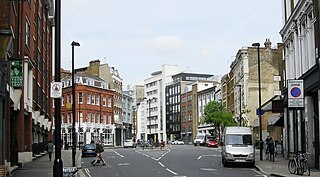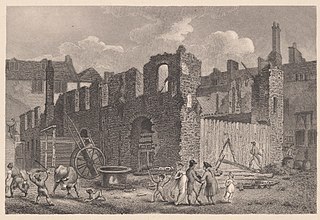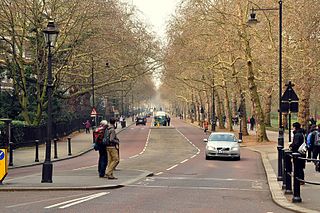Coordinates: 51°27′10.11″N2°35′46.27″W / 51.4528083°N 2.5961861°W

A geographic coordinate system is a coordinate system that enables every location on Earth to be specified by a set of numbers, letters or symbols. The coordinates are often chosen such that one of the numbers represents a vertical position and two or three of the numbers represent a horizontal position; alternatively, a geographic position may be expressed in a combined three-dimensional Cartesian vector. A common choice of coordinates is latitude, longitude and elevation. To specify a location on a plane requires a map projection.

Marsh Street is a street in the city of Bristol, England.

Bristol is a city and county in South West England with a population of 459,300. The wider district has the 10th-largest population in England. The urban area population of 724,000 is the 8th-largest in the UK. The city borders North Somerset and South Gloucestershire, with the cities of Bath and Gloucester to the south-east and north-east, respectively. South Wales lies across the Severn estuary.

England is a country that is part of the United Kingdom. It shares land borders with Wales to the west and Scotland to the north-northwest. The Irish Sea lies west of England and the Celtic Sea lies to the southwest. England is separated from continental Europe by the North Sea to the east and the English Channel to the south. The country covers five-eighths of the island of Great Britain, which lies in the North Atlantic, and includes over 100 smaller islands, such as the Isles of Scilly and the Isle of Wight.
Located in the historic city centre of Bristol, it runs in a northerly direction for about 200 yards from its junction with King Street and Prince Street to Clare Street.

King Street is a 17th-century street in the historic city centre of Bristol, England.
The street is noted in the diary of Samuel Pepys as the birthplace of his maid and love interest Deb Willet. [1] [2]

Samuel Pepys was an administrator of the navy of England and Member of Parliament who is most famous for the diary he kept for a decade while still a relatively young man. Pepys had no maritime experience, but he rose to be the Chief Secretary to the Admiralty under both King Charles II and King James II through patronage, hard work, and his talent for administration. His influence and reforms at the Admiralty were important in the early professionalisation of the Royal Navy.
Deborah Willet (1650–1678) was a young maid employed by Samuel Pepys (1633–1703), an English naval administrator and Member of Parliament. She and Pepys, 17 years her senior, engaged in a liaison that was chronicled in his famous diary. When Pepys's diary first was published in the late nineteenth century, the more explicit parts describing the author's affair with Deb Willet were not printed. They only appeared in the most-recent version of the diary.
In 1967, the Bristol and West building society built its then headquarters in Marsh Street. The building has since been converted to different use.
Bristol & West (B&W) was a former building society in the United Kingdom, one of the first to be demutualised to become a commercial bank. It became a division of the Bank of Ireland in 1997. Bristol & West had its headquarters in Bristol, England. The bank's main activity was mortgage lending for residential and commercial customers, although in 2009 its business was transferred to Bank of Ireland and it became a shell company and stopped accepting new customers. The Bristol & West name has since been replaced by the Bank of Ireland brand.

The former Bristol and West Building on Marsh Street/St Augustine's Parade, Bristol was built in 1967 by Alec French and partners.

















